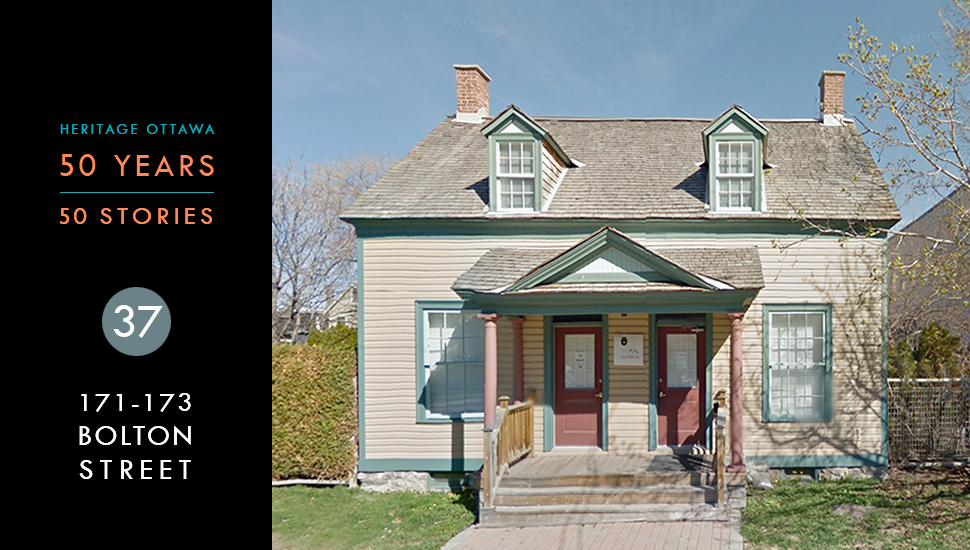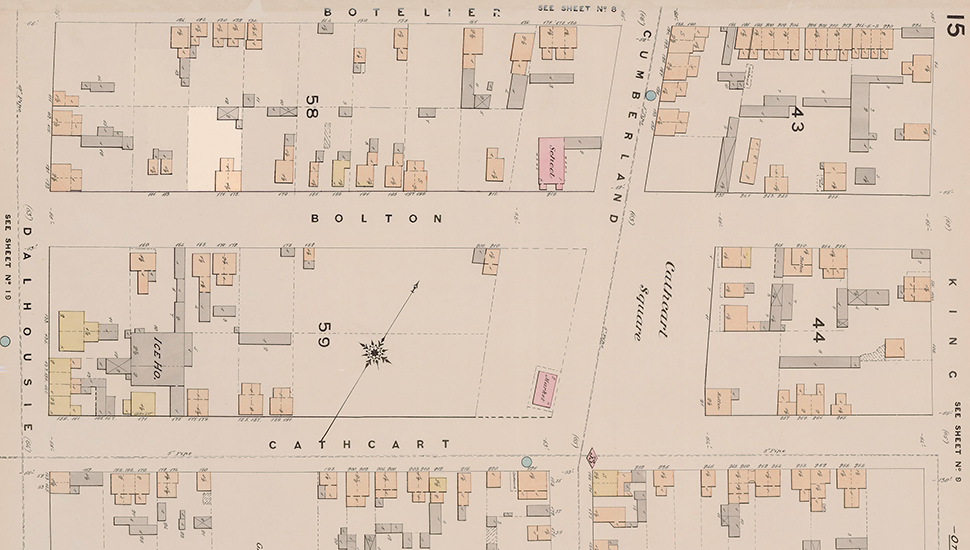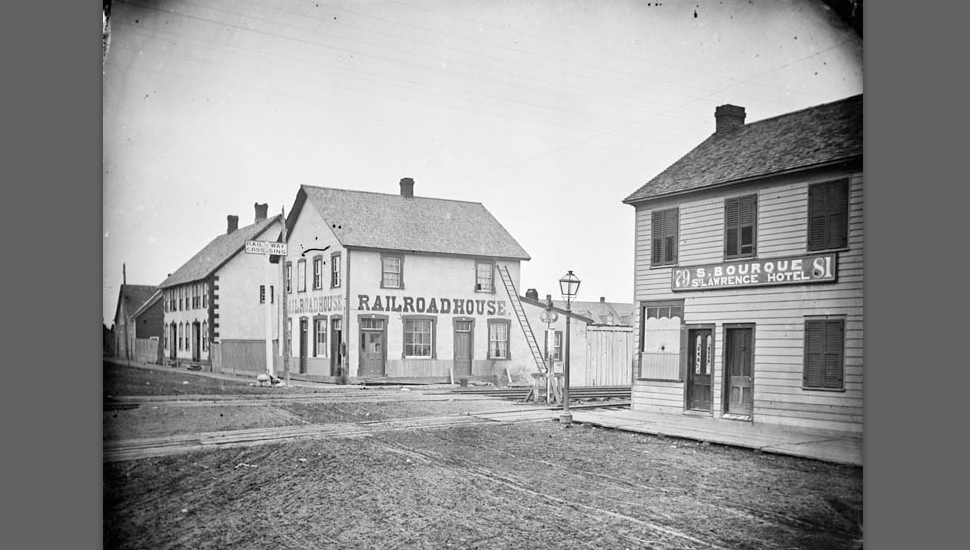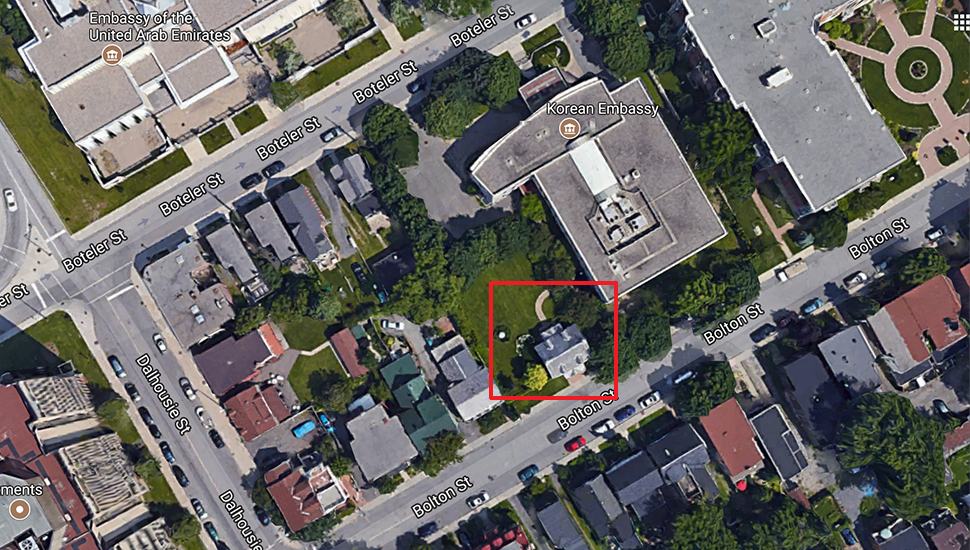37. Double House at 171 - 173 Bolton Street
Construction: Circa 1861 | Restoration: 1998
Architect: Unknown | Restoration: Larry Gaines Architect
Location: 171-173 Bolton Street, Ottawa
Located in the north-west section of Lowertown between Dalhousie and Cumberland streets, the double-house at 171-173 Bolton Street was built prior to 1861 when Lowertown was a predominatly working class neighbourhood. The earliest owner-occupant was James McEwen, a labourer and farmer. Tenants who occupied the building during its first 50 years included a joiner, labourers and a dressmaker.
A modest Classical Revival style 1 ½ storey, side-gable building, 171-173 Bolton Street is reputed to be of square-timber frame construction. The low pitch roof had two symmetrical dormers and brick end chimneys. The exterior was clad in bevel wood siding with plain corner boards. Centred on the front elevation, and protecting the two entrance doors, was a shed roofed wood porch with a central pediment supported by a pair of circular columns with Doric capitals and moulded bases. Either side of the porch is flanked by two 6-over-6 vertical sash windows.
Sections of Lowertown East were demolished during the 1960s in the name of “urban renewal”. In 1991, increasing development pressure in Lowertown West led the City of Ottawa to commission a study to determine whether Lowertown West merited designation as a Heritage Conservation District under the Ontario Heritage Act.
In June 1992, the Embassy of the Republic of Korea purchased an L-shaped lot consisting of house numbers 167-169 (a brick double dating from 1914) and 171-173 Bolton Street, plus three adjoining lots on Boteler Street. The City granted the rezoning required to construct a new Chancellery on the vacant portion of the property.
A direct threat materialized quickly. Heritage Ottawa learned that the Embassy’s offer of purchase had been conditional on obtaining permission to demolish the buildings. Heritage Ottawa quickly organized a meeting with Embassy officials in March 1993 to discuss preservation of the buildings. John Leaning, an architect and Heritage Ottawa member, proposed that the buildings be incorporated into the design plan for the new development.
The Embassy, however, proceeded with its original plan and submitted an application to demolish both properties on July 30, 1993. The City put the application on hold, subject to the receipt of site plans for the two properties. Heritage Ottawa’s objections were supported by the Heritage Canada Foundation and Councillor Stéphane Émard-Chabot, who intervened with the Embassy and the federal ministers of heritage and foreign affairs.
At the same time, designation of the Lowertown West Heritage Conservation District (HCD) was approved by Ottawa City Council. The designation identified both buildings as “an important part of this grouping of heritage buildings on Bolton Street” and “early examples of workers’ houses in Lowertown.” The Embassy filed an appeal to the Ontario Municipal Board (OMB) against inclusion of the Bolton Street properties in the HCD designation. The appeal was denied. In June 1995, the OMB approved the inclusion of both 167-169 and 171-173 Bolton Street in the HCD, in accordance with the designation Bylaw 192-94.
By 1996, concerns that the now-vacant buildings at 167-169 and 171-173 Bolton would not survive another winter without intervention led Heritage Ottawa to meet with Embassy staff and City Councillor Émard-Chabot. Alternatives to demolition were discussed, including moving the 171-173 Bolton Street building to either the Township of Cumberland Museum village complex, nearby property belonging to the Ottawa Roman Catholic Separate School Board, or land owned by the National Capital Commission.
By January 1997, the Korean Embassy acknowledged that moving 171-173 Bolton off-site would not satisfy local heritage concerns, and proposed an alternative involving demolition of the 1914 structure at 167-169 Bolton, while moving the double-house at 171-173 to the newly vacant site and rehabilitating it. Before year-end, a compromise was reached with the City allowing the demolition of 167-169, but retaining the rehabilitated building at 171-173 Bolton Street on its original site.
Heritage Ottawa's President, Carolyn Quinn, stated the organization's position to the City as follows: “[w]e would like to go on record as stating our regret that in order to save one heritage building, another heritage building must be sacrificed.”
In January 1998, Larry Gaines Architect (on behalf of the Embassy of the Republic of Korea) submitted a restoration proposal for 171-173 Bolton Street to the City, which was approved. The work included structural stabilization, reinstatement of original wood sheathing, restoration and reproduction of original wood windows, doors and other decorative woodwork.
The project was awarded a Certificate of Merit at the 1999 City of Ottawa Architectural Conservation Awards.
The 171-173 Bolton Street dwelling is now functionally incorporated into the compound of the Embassy of the Republic of Korea Cultural Centre, where it serves as a public cultural centre and is used by the King Sejong Institute in Ottawa.




